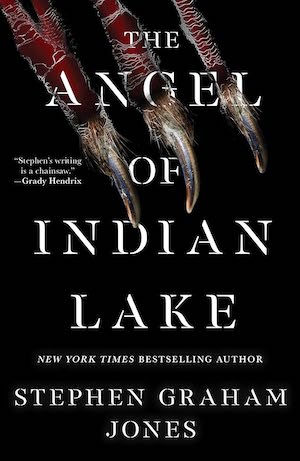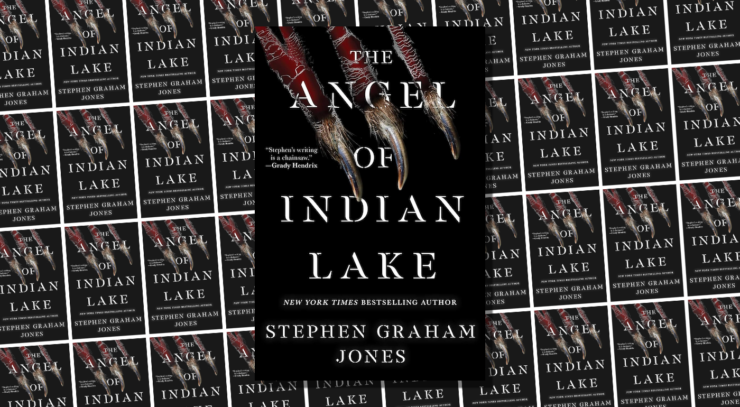There’s something inherently daunting about writing a trilogy that’s set outright in the horror genre. I’d argue that this has to do with something more pronounced in horror than in most other genres: the element of surprise. More specifically, it’s the sense that no one is safe. (Cue Jamie Kennedy shouting, “Everyone’s a suspect!” in Scream.) Trilogies—and series more broadly—promise some sense of continuity. (Though that can sometimes be upended. Just ask Ned Stark.) With horror, the protagonist might not survive until the last sentence—or they might end up becoming the very monster they’ve opposed.
The Angel of Indian Lake is the final volume in Stephen Graham Jones’s Indian Lake trilogy, following My Heart is a Chainsaw and Don’t Fear the Reaper. It’s a work of horror, both human-scale and supernatural, and it also takes more than a few cues from the tropes of slasher films. It’s a bold narrative juggling act, a book that’s in dialogue both with its two predecessors and with an entire subgenre of films. Jones has veered into this territory before: one of his earlier novels is titled The Last Final Girl, and his novella Night of the Mannequin contained plenty of horror-film imagery.
The Indian Lake novels are different. On paper, they might sound at least somewhat similar to Peter Straub’s Blue Rose trilogy; both have plenty of real-life horrors and both incorporate more than a little genre knowledge and metafictional flair. (The third volume in Straub’s trilogy was, in fact, where I first encountered the concept of metafiction.) But what might look similar on paper is radically different in execution: Graham’s trilogy is in some ways more traditional than Straub’s, in that it follows one consistent set of characters over a relatively confined period of times—but it’s also stranger in others.
The antagonists in these books are both human and supernatural, for one thing. For another, the characters—especially series protagonist Jade Daniels—are aware that they’re in a situation that operates under the rules of the horror genre. What this often means for Jade is attempting to understand which of the people around her fits into the narrative in the role of “final girl”—and how that might lead to some respite from the restless ghosts, bloodthirsty killers, or abusive relatives around them.
Buy the Book


The Angel of Indian Lake
The Angel of Indian Lake is set four years after the events of Don’t Fear the Reaper. Jade, who was a high school student when the trilogy began, is now teaching at her hometown’s high school—and dealing with the aftermath of her time spent incarcerated following the events of the previous books. Jade’s position as an authority figure brings back memories of Mr. Holmes, the teacher who inspired her during her own time as a student—and whose memory is summoned up during some of Jade’s first-person narration.
Letha, Jade’s friend and a fellow horror aficionado, remains off the page for much of the novel, which speaks in part to the different paths in life that both women have had. Neither is quite the archetypal “final girl” of countless horror tropes—Jade is Indigenous; Letha is Black—and their paths in life include more than a few other contrasts. Jade is on her own; Letha is married with a child. Letha comes from an affluent family; Jade’s roots are more humble. Slasher films don’t often riff on questions of race, gender, and class, but Jones certainly does in his trilogy. Via the setting of Proofrock, Idaho, these novels reckon with everything from the bloodier side of the nation’s westward expansion to the ways in which Mountain West states have become destinations for the absurdly wealthy.
As in past installments in the trilogy, Jones juxtaposes supernatural threats to the town with more mundane examples of the evil that people are capable of. Rexall, a friend of Jade’s father with a penchant for voyeurism, had been a slow-burning presence in the books until this volume; this time out, Jones reveals more about just what makes Rexall tick and what he might do if he became an outright threat, as opposed to a leering presence. The results are appropriately unsettling.
He’s far from the only threat here, though. Jade’s first warning that all might not be well in Proofrock is the return of an object that’s been long unaccounted for. That turns out to be a herald for something much more menacing: the return of several members of the town’s dead, now seeking revenge on those who wronged them. It wouldn’t be the conclusion of a trilogy without a few old faces returning for sinister purposes, and Jones makes good on that implicit promise as well.
Jones has given himself a difficult narrative juggling act here—one where these books need to work as, effectively, slasher films in literary form while also acting as a kind of meta-narrative meditation on slasher tropes and archetypes. What’s miraculous here is that he pulls it off. It doesn’t hurt that The Angel of Indian Lake features a structure that alternates Jade’s first-person narration with a series of found documents by an author who turns out to be connected to one of the trilogy’s most interesting character arcs.
The Angel of Indian Lake is a dense and at times dizzying read, and one that juxtaposes several varieties of horror together to make one especially potent narrative. It’s the literary equivalent of a garage rock recording that also turns out to be gloriously baroque, and accomplishes the trick of holding a mirror up to the horror genre’s history while also reading like little else you’ll encounter.
The Angel of Indian Lake is published by Saga Press.










